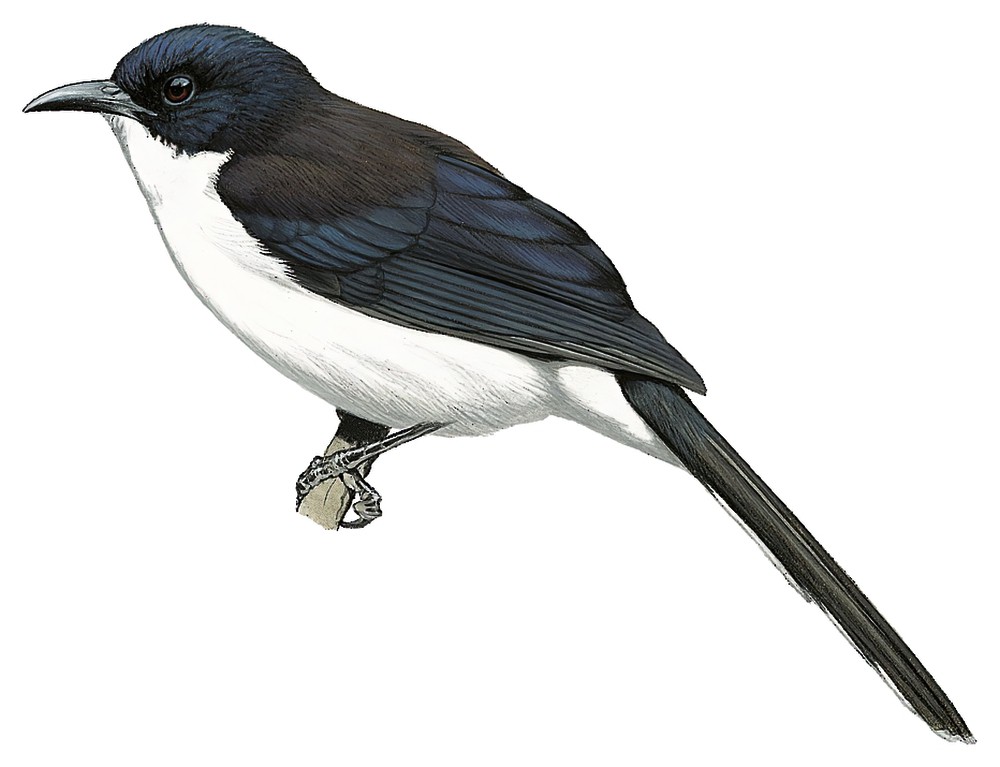Black-backed Sibia / Heterophasia melanoleuca

Black-backed Sibia
SCI Name:
Protonym: Sibia melanoleuca J.Asiat.Soc.Bengal 28 p.413
Taxonomy: Passeriformes / Leiothrichidae / Heterophasia
Taxonomy Code: blbsib1
Type Locality: Tenasserim; type from Mulayit Taung [lat. 16° ir N., long. 98° 32'' E.], fide Tickell, 1859, ibid., 28, p. 451.
Author: Blyth
Publish Year: 1859
IUCN Status: Least Concern
DEFINITIONS
HETEROPHASIA
(Leiothrichidae; Ϯ Long-tailed Sibia H. picaoides) Gr. ἑτερος heteros different; φασις phasis appearance < φαινω phainō to appear; “Heterophasia, Nobis, n. g? A curious meruline form, exhibiting affinity for various distinct genera, but which cannot be immediately approximated to any with which I am acquainted. It has long rounded wings, a very long and much graduated tail, slender and slightly curving bill, and rather short tarsi. Bill longer than the head, slender, tapering, a little incurved, its base as high as broad, and gradually more compressed for the basal ¾ths; the ridge of the upper mandible distinct (but not sharp) to beyond the nostrils, then rather less so, and its tip very slightly if at all emarginated: nostrils somewhat large, and almost closed by impending membrane, the naral orificies appearing as mere fissures on the inferior margin of this, though more apart anteriorly: a few small setæ at the gape. Tarse somewhat longer than the middle toe; and the claws compressed and suitable for perching. Wings having the 5th or 6th primary longest, and the 7th equal to the 4th. Tail broad and very much lengthened and graduated. The plumage throughout is soft, dense, and smooth; the wings and tail tolerably firm. 34. H. cuculopsis, Nobis. ... At a first glance, this bird is apt to be mistaken for Cuculidous; an appearance to which its large and lengthened graduated tail, each feather tipped with whitish, its incurved bill, and the general hue of its colouring, alike contribute. From Darjeeling.” (Blyth 1842); "Heterophasia Blyth, 1842, Journ. Asiat. Soc. Bengal, 11, p. 186. Type, by monotypy, Heterophasia cuculopsis Blyth = Sibia picaoides Hodgson." (Deignan in Peters, 1964, X, p. 416).
Var. Heterophosia.
Synon. Malacias.
melanoleuca / melanoleucos / melanoleucus
Gr. μελας melas, μελανος melanos black; λευκος leukos white.
● ex "Buff-crested Woodpecker" of Latham 1782 (Campephilus).
● ex “Águila obscura y blanca” of de Azara 1802-1805, no. 8 (Geranoaetus).
● “As Columba picata Latham 1801, was regularly used as valid in the 20th century, this precludes invoking the principle of reverse of precedence (ICZN 1999: 23.9.1.1, 23.9.1.2)” (McAllan 2007) (syn. Leucosarcia picata).
● ex “Esparvero negriblanco” of de Azara 1802-1805, no. 28 (syn. Micrastur semitorquatus).
● ex “Plus petit Barbu à poitrine noir de Cayenne” of d’Aubenton 1765-1781, pl. 688, fig. 2, “Plus petit Tamatia noir et blanc” of de Buffon 1770-1785, and “Lesser Pied Barbet” of Latham 1782 (syn. Notharchus tectus).
● ex “Coucou huppé de la côte de Coromandel” of d’Aubenton 1765-1781, pl. 872, “Jacobin huppé de Coromandel” of de Buffon 1770-1786, and “Coromandel Crested Cuckow” of Latham 1782 (syn. Oxylophus jacobinus).
● ex “Chipiu negro y blanca” of de Azara 1802-1805, no. 144 (Poospiza).
● ex “Stone Snipe” of Pennant 1785, and Latham 1785 (Tringa).
● ex “Cordon Noir” of Levaillant 1805, pl. 150 (Sylvia artefact).
Melanoleuca
(syn. Pica Ϯ Common Magpie P. pica) Gr. μελας melas, μελανος melanos black; λευκος leukos white; "Melanoleuca pica, Magpie." (Morris 1837) (OD per Björn Bergenholtz).
SUBSPECIES
Black-backed Sibia (melanoleuca)
SCI Name: Heterophasia melanoleuca melanoleuca
melanoleuca / melanoleucos / melanoleucus
Gr. μελας melas, μελανος melanos black; λευκος leukos white.
● ex "Buff-crested Woodpecker" of Latham 1782 (Campephilus).
● ex “Águila obscura y blanca” of de Azara 1802-1805, no. 8 (Geranoaetus).
● “As Columba picata Latham 1801, was regularly used as valid in the 20th century, this precludes invoking the principle of reverse of precedence (ICZN 1999: 23.9.1.1, 23.9.1.2)” (McAllan 2007) (syn. Leucosarcia picata).
● ex “Esparvero negriblanco” of de Azara 1802-1805, no. 28 (syn. Micrastur semitorquatus).
● ex “Plus petit Barbu à poitrine noir de Cayenne” of d’Aubenton 1765-1781, pl. 688, fig. 2, “Plus petit Tamatia noir et blanc” of de Buffon 1770-1785, and “Lesser Pied Barbet” of Latham 1782 (syn. Notharchus tectus).
● ex “Coucou huppé de la côte de Coromandel” of d’Aubenton 1765-1781, pl. 872, “Jacobin huppé de Coromandel” of de Buffon 1770-1786, and “Coromandel Crested Cuckow” of Latham 1782 (syn. Oxylophus jacobinus).
● ex “Chipiu negro y blanca” of de Azara 1802-1805, no. 144 (Poospiza).
● ex “Stone Snipe” of Pennant 1785, and Latham 1785 (Tringa).
● ex “Cordon Noir” of Levaillant 1805, pl. 150 (Sylvia artefact).
Black-backed Sibia (castanoptera)
SCI Name: Heterophasia melanoleuca castanoptera
castanoptera / castanopterum / castanopterus
Gr. καστανον kastanon chestnut; -πτερος -pteros -winged < πτερον pteron wing.
● ex “Chesnut Coucal” of Latham 1822 (syn. Centropus sinensis).
UPPERCASE: current genus
Uppercase first letter: generic synonym
● and ● See: generic homonyms
lowercase: species and subspecies
●: early names, variants, mispellings
‡: extinct
†: type species
Gr.: ancient Greek
L.: Latin
<: derived from
syn: synonym of
/: separates historical and modern geographic names
ex: based on
TL: type locality
OD: original diagnosis (genus) or original description (species)












